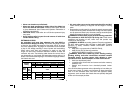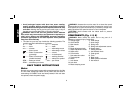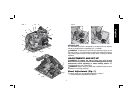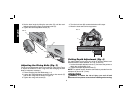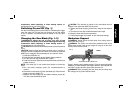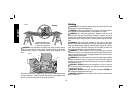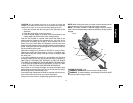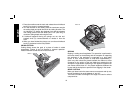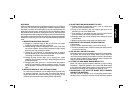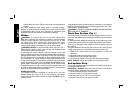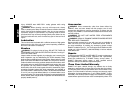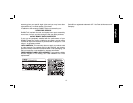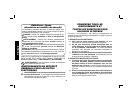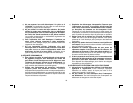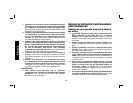
English
13
KICKBACK
When the saw blade becomes pinched or twisted in the cut, kickback
can occur. The saw is thrust rapidly back toward the operator. When
the blade is pinched or bound tightly by the kerf closing down, the
blade stalls and the motor reaction drives the unit backward. When
the blade becomes twisted or misaligned in the cut, the teeth at the
back edge of the blade can dig into the top surface of the wood causing
the blade to climb out of the kerf and jump back toward the operator.
Kickback is more likely to occur when any of the following conditions
exist.
1. IMPROPER WORKPIECE SUPPORT
A. Sagging or improper lifting of the cut off piece can cause
pinching of the blade and lead to kickback.
B. Cutting through material supported at the outer ends only
can cause kickback. As the material weakens it sags, closing
down the kerf and pinching the blade.
C. Cutting off a cantilevered or overhanging piece of material
from the bottom up in a vertical direction can cause kickback.
The falling cut off piece can pinch the blade.
D. Cutting off long narrow strips (as in ripping) can cause
kickback. The cut off strip can sag or twist closing the kerf and
pinching the blade.
E. Snagging the lower guard on a surface below the material
being cut momentarily reduces operator control. The saw
can lift partially out of the cut increasing the chance of blade
twist.
2. IMPROPER DEPTH OF CUT SETTING ON SAW
To make the most efficient cut, the blade should protrude only
far enough to expose 1/2 of a tooth. This allows the shoe to
support the blade and minimizes twisting and pinching in the
material. See the section titled Cutting Depth Adjustment.
3. BLADE TWISTING (MISALIGNMENT IN CUT)
A. Pushing harder to cut through a knot, a nail, or a hard grain
area can cause the blade to twist.
B. Trying to turn the saw in the cut (trying to get back on the
marked line) can cause blade twist.
C. Over-reaching or operating the saw with poor body control
(out of balance), can result in twisting the blade.
D. Changing hand grip or body position while cutting can result
in blade twist.
E. Backing up the saw to clear blade can lead to twist.
4 MATERIALS THAT REQUIRE EXTRA ATTENTION
A. Wet lumber
B. Green lumber (material freshly cut or not kiln dried)
C. Pressure treated lumber (material treated with preservatives
or anti-rot chemicals)
5. USE OF DULL OR DIRTY BLADES
Dull blades cause increased loading of the saw. To compensate,
an operator will usually push harder which further loads the
unit and promotes twisting of the blade in the kerf. Worn blades
may also have insufficient body clearance which increases the
chance of binding and increased loading.
6. LIFTING THE SAW WHEN MAKING BEVEL CUT
Bevel cuts require special operator attention to proper cutting
techniques - especially guidance of the saw. Both blade angle
to the shoe and greater blade surface in the material increase
the chance for binding and misalignment (twist) to occur.
7. RESTARTING A CUT WITH THE BLADE TEETH JAMMED
AGAINST THE MATERIAL
The saw should be brought up to full operating speed before
starting a cut or restarting a cut after the unit has been stopped



